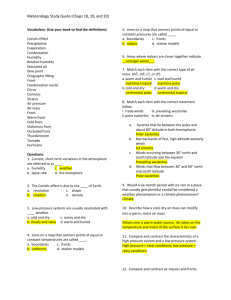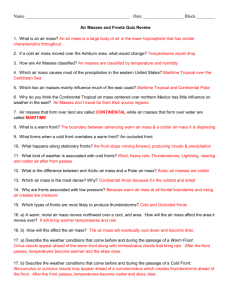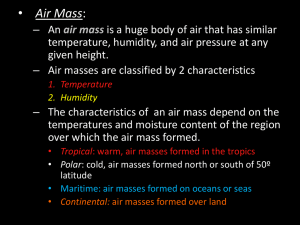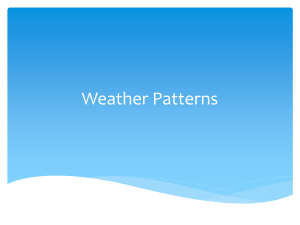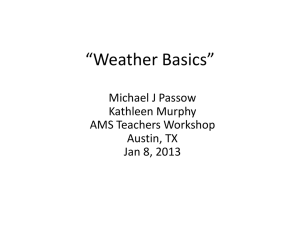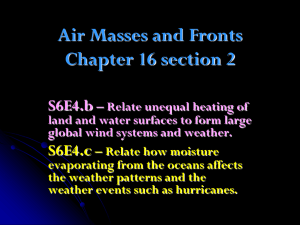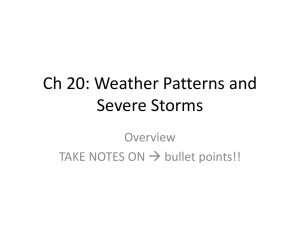Chapter 8 - Weather Underground
advertisement
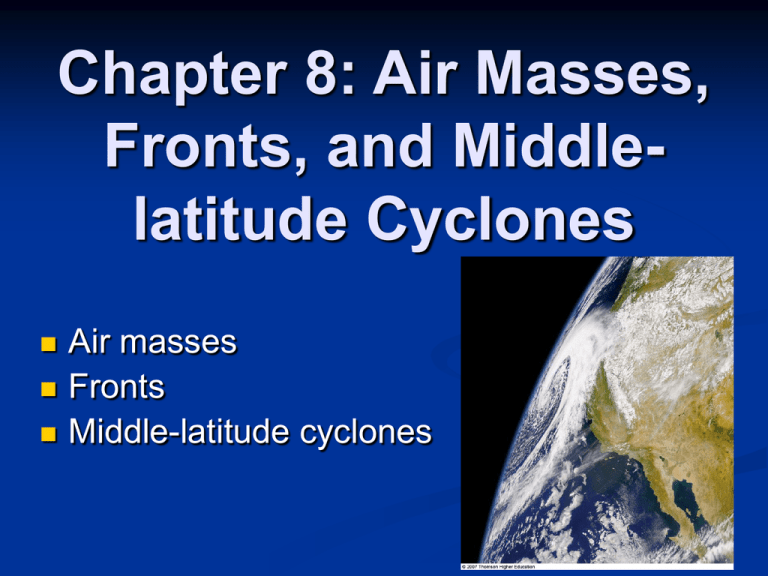
Chapter 8: Air Masses, Fronts, and Middlelatitude Cyclones Air masses Fronts Middle-latitude cyclones Source Regions Air mass – a large body of air with relatively similar qualities of air. Air is same temperature in the horizontal Source regions – regions where air masses obtain their characteristics The best way to obtain its characteristic is for the air to remain over an area for a long time Thus, what type of weather system is best for a source region? • Because air sinks in high pressure systems, air stays in contact with the surface and acquires its temperature and moisture characteristics. Source Regions High pressure systems are best at source regions Air is stagnant, and remains for a long time What areas of Earth have good source regions then? Source Regions Source Regions Table 8-1, p. 205 Classification Air masses classified by temperature and humidity (cold air masses and dry air masses Air masses originating over land start with c (continental)…over water start with m (maritime) Air masses that are Arctic start with (A), Polar (P), or Tropical (T) cP (Continental Polar) and cA (Continental Arctic) Air Masses Continental polar and Continental arctic Bitterly cold, dry air masses that originate over northern Canada and Alaska Clear, nights and snow covered lands create very cold air Moves into the United States by air aloft Can create lake effect snow when the cold dry air passes over a “warm” lake. Water evaporates and creates snow downwind of the lake cP (Continental Polar) and cA (Continental Arctic) Air Masses mP (Maritime polar) Air Masses mP Air mass may originate from northern Asia and become modified as it cross the Pacific. Ocean adds warmth and moisture mP (Maritime polar) Air Masses Pacific Air is modified mP as it moves over mountains mT (Maritime Tropical Air Masses) Much of California’s winter precipitation comes from mT air masses Subtropical air – air originating from the subtropics Bermuda high – on the East coast, flow around the Bermuda high produces mT air that flows in the Southeast • mT air brings hot, muggy air to the eastern US in summer. mT (Maritime Tropical Air Masses) mT (Maritime Tropical Air Masses) Stationary Fronts Front – a boundary between air masses of differing densities (another defintion?) Stationary Fronts Stationary front – a front with basically no movement Alternating blue triangles and red semicircles Winds blow parallel to front Cold Fronts Cold front – region where cold, dry air is replacing warm, moist conditionally unstable air Drawn with triangles pointing to the direction of movement Cold fronts can be diagnosed in a number of ways Sharp temperature changes Change in air’s moisture content Shift in wind direction Pressure changes Clouds or precipitation Cold Fronts Warm Fronts Warm front – boundary where warm air replaces cold air Overrunning – warm air moving above cold air well ahead of the front Drawn as red semicircles pointing the direction of movement Cause precipitation to form far ahead of the front Slope of a warm front is much more gentle Precipitation can change from snow to rain Changes across the front are less dramatic than in cold fronts Warm Fronts Occluded Fronts Occluded front – occurs when a cold front catches a warm front Marked by semicircles and triangles pointing in the same direction Cold occlusion – air behind front is colder than air ahead Warm occlusion – air ahead of a front is colder than air behind it Polar Front Theory Polar Front Theory – describes the life cycle of a mid-latitude storm Wave cyclone – how a storm develops, in a wavelike manner Frontal wave – initial formation of a kink in an isobar (start of a low pressure system) Open wave – second stage of development Warm sector – region of warm air between the warm front and the cold front (partly cloudy) Energy for the storm comes from condenstation and wind speeding towards the low center Polar Front Theory Mature cyclone – stage when occluded front initially forms (most intense) Advanced occlusion – occurs when cold air is on both sides of the occluded front. Dying storm Stepped Art Fig. 8-23, p. 223 Where Do Mid-latitude Cyclones Tend to Form? Cyclogenesis Any strengthening of a mid-latitude storm Lee-side low East of Rockies Storms that move up the east coast are nor’easters Developing Mid-latitude Cyclones and Anticyclones Convergence and divergence If the upper-level low is directly above the surface low, then the storm will weaken Jet Streams and Developing Mid-latitude Cyclones Jet streams can help with divergence or convergence Jet streak – an area of strong wind • During World War II, the jet stream was used by the Japanese to carry balloon bombs across the Pacific Ocean to North America.
